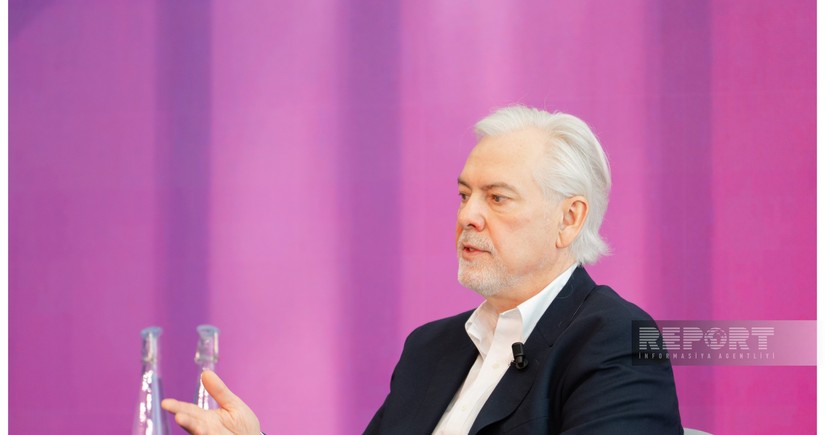PMI chief: 'We must stop behaving as if we are still living in 19th century'
- 12 June, 2025
- 10:33

Recent years have seen a steady decline in the number of people consuming tobacco worldwide. According to the World Health Organization, while in 2000, every third adult in the world smoked or used tobacco products, by 2020 this figure had decreased to every fifth inhabitant of the planet. Despite the decline in smoking rates, currently more than 1.2 billion people worldwide remain consumers of cigarettes, which continue to claim millions of lives annually.
To reduce the negative impact of smoking, manufacturers are developing new technologies, with smoke-free tobacco products becoming the main trend. One of the pioneers in the field of smoke-free products is Phillip Morris International (PMI), which has been producing a line of smoke-free tobacco products since 2014.
PMI CEO Jacek Olczak has shared his thoughts with Report about the company's further development and the reduction of cigarette consumption worldwide.
- Smoke-free tobacco products are already present in 95 markets, and you have stated your goal to reach 100 markets by 2025. Could you share stories where governments accept such products to address the problem of smoking? What can these examples teach other countries?
- There are markets where different categories of smoke-free products are represented – heated tobacco products, electronic cigarettes, and others. And in such markets, you see the fastest switch of smokers to smoke-free products. But, for example, in markets such as Vietnam, Türkiye, Taiwan, India, and several others, smoke-free products are completely banned, and there we don't see any decline in cigarette sales. Several Latin American countries, such as Argentina and Brazil, also demonstrate a controversial position regarding smoke-free products, where they haven't yet fully determined the prospects for smoke-free products. On the other hand, in Japan, we see a very rapid decline in smoking rates by 50%. Already today, the category of smoke-free products there exceeds the volume of cigarette products. In Sweden, the level of cigarette consumption does not reach even 5% of the population, which is incomparably lower than the level in continental Europe and other countries. In countries where governments accept smoke-free tobacco products into circulation, the dynamics of the decline in smoking rates are completely different.
- Do governments apply different tax regimes for cigarette and smoke-free tobacco products? How do you work with governments to reduce cigarette consumption, and how do governments recognize the role of smoke-free products in the global fight against smoking?
- Despite the decline in cigarette smoking rates in countries that are loyal to smoke-free tobacco products, the World Health Organization completely denies the possibilities for smoke-free products and believes that they should be regulated exactly the same as cigarettes. Regarding tax regulation, in general, up to 80% of the cost of cigarettes consists of taxes. Reducing smoking levels requires additional efforts from governments to compensate for tax losses. In any case, we see that a number of countries apply a lower tax rate for smoke-free products compared to cigarettes. The difference in taxes can range from 40% to 70%, depending on the government's position. This allows us to reduce the price of smoke-free products.
- Are smoke-free tobacco products part of PMI's Environmental, Social, and Governance (ESG) goals? What KPI metrics do you track?
- It is fundamentally impossible to talk about social responsibility in a company that sells only cigarettes. Therefore, our first goal is to replace cigarette sales with smoke-free tobacco products. By 2030, we, as PMI, have set a goal to generate 2/3 of our gross revenue exclusively from the sale of smoke-free products. Currently, in 29 markets, more than 50% of our revenue comes from smoke-free products, and in 6 markets, 3/4 of our revenue. In the first quarter of 2025, 42% of all our revenue was related to the smoke-free product category. Considering that 10 years ago this figure was zero, this is phenomenal progress. PMI was not present in Azerbaijan for a long time and recently returned to the market, introducing its smoke-free products.
- Türkiye and India are large consumers of cigarette products. What is the justification for their ban on smoke-free products, which, according to your research, are not as harmful as cigarettes?
- These countries have been talking about the lack of scientific data in healthcare for the last 10 years. Meanwhile, many in the world have realized that this product is incomparable to cigarettes. The second argument is the use of this product by minors, but this argument is unfounded and unconfirmed. For our part, we are implementing a mechanism to prevent this product from falling into the hands of minors. A number of countries in Europe, as well as Japan, are fully utilizing the potential of smoke-free products, and there we see a real decline in smoking rates. In countries where these products are banned, we continue discussions. For example, in Greece, we see a significant decrease in smoking rates, while in Türkiye, it's the opposite.
- Can you tell us about the challenges you face in scientific research regarding the health effects of smoke-free products and their potential dangers?
- The bigger challenge is not science, but the regulation of this sector. If the regulator tells a smoker that there is no difference between cigarettes and smoke-free tobacco products, then naturally, there is no incentive for the smoker to switch to a less harmful product.
- What can countries do to eliminate smoking in the next 10 years?
- Technology and innovation can solve this issue. We see this in other areas as well. You can see how car manufacturing has developed, and how safe cars are now. The same applies to almost all areas of our lives. We must stop behaving as if we still live in the 19th century. We can continue to sell cigarettes today. But this is our wake-up call to all countries. We must adopt technologies and innovations.
